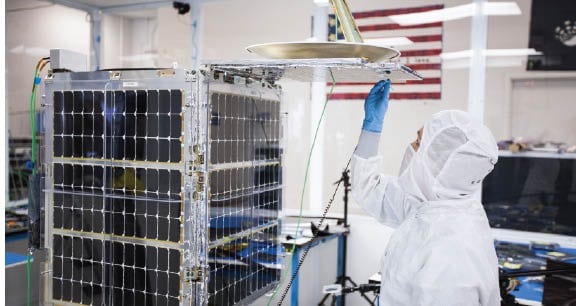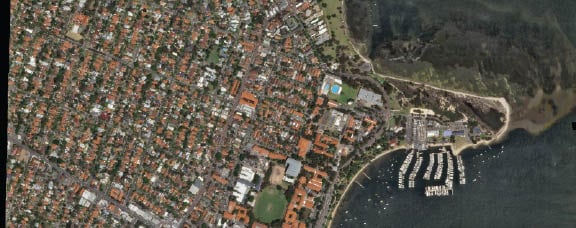Latest News
As we head into the SmallSat Conference next week in Utah, this interview with Dan Berkenstock, our 2014 Satellite Executive of the Year, is a good reminder of how fast things are moving in the NewSpace era. Back then, the 5-year-old company was still called Skybox and it had just been acquired by Google, a deal that made a huge impact in our industry. Only three years later, Google sold it to Planet, one of Terra Bella’s main competitors — another huge story in our industry. Here’s a look back at what Berkenstock’s outlook was back then. This article was originally published in February 2015.
Skybox Imaging has been one of the success stories of the satellite sector in recent years. The company, which was created only a few years ago, was sold to Google in 2014 in a deal worth $500 million. It has been a story of superb entrepreneurship reinventing the satellite imaging landscape at a stroke. It is for these reasons, that our Satellite Executive of the Year for 2014 is the driving force behind Skybox: Dan Berkenstock, the founding CEO of the company and now head of product and partner development at Skybox at Google.
In 2007, Dan Berkenstock was in grad school at Stanford University in California, trying to figure out a future direction. Less than eight years later, he is the Satellite Executive of the Year for 2014. To say his rise has been meteoric would be an understatement. In a major interview with Via Satellite celebrating Berkenstock’s and his teams achievement in making Skybox Imaging a success, he talks candidly about the early days, the first conversations with Google, as well as his reaction to seeing the first images that came back from the SkySat 1 satellite.
VIA SATELLITE: On your Ted Talk last year, you mentioned the solution you initiated for Skybox had been in front of you the whole time. Can you tell us when the concept of Skybox first came to your mind?
Berkenstock: The precursor for Skybox was a Stanford attempt for the Google Lunar X Prize back in 2007. When the prize was announced we realized we had this social circle in grad school with people who could both build CubeSats and knew the Silicon Valley tricks for building Web software. We had about 40 people working on a conceptual design, including three of the four Skybox cofounders. When the economy collapsed, so did Stanford’s interest in our fundraising for a university-sanctioned race to the Moon.
I was excited about the technology approach we had taken and sort of became addicted to the idea of starting a venture that we could take farther. While in grad school I was also working in nuclear non-proliferation and that spawned my interest in imagery. As a non-proliferation analyst, I wasn’t the satellite designer — I was the end-user with the problem. I began to realize how satellite imagery today may be ubiquitous, but it isn’t timely enough to provide daily insight into economic and other societal trends.
As I began to talk to more and more with current users of imagery it became clear that I wasn’t alone in wanting an easier experience in obtaining both imagery as well as the information content locked within it. Pretty soon [my co-founder] Julian Mann and I were trying to determine whether we could jam a commercial lens and camera into a CubeSat. There were a number of twists and turns before we actually materialized as Skybox, but I think that was the point where we both decided we were going to try to turn our idea into something real.
VIA SATELLITE: Was it always your ambition to build a business in satellite or had you looked at other options in terms of technology and engineering when looking to build a business?
Berkenstock: Being a PhD student at Stanford was really the catalyst. For the first time in my life I was exposed to people who had built companies from scratch and I was intensely drawn to the idea of creating something from nothing. I was in the Aeronautics and Astronautics department and had worked at NASA (both at Johnson Space Center and Ames). So working in satellites was a much more natural fit than social media; though, to be honest, I was more of a software developer than satellite designer. Fortunately, I had some good friends that turned out to be amazing and exceptionally creative satellite engineers.
I’m really excited about the tidal wave of new data sources that are being created by low cost sensors and the ways they will allow humanity to make better, smarter and safer decisions on a daily basis, be they wearable step sensors or satellites. I also really care about health and understanding the impact of environment on health so we briefly looked at networking indoor air quality sensors for home use. But once the Google Lunar X Prize came along it was satellites or bust.
VIA SATELLITE: Back in 2008-2009, the economy was not in great shape. Did you ever have any doubts that you could get the funding and that you could build a business in these challenging times?
Berkenstock: Financing any satellite project is difficult, far more difficult than it seems when you start with an idea on the back of an envelope. The economic collapse was a mixed blessing. Venture capitalists had slowed investing overall, but there is also a key tenet in Silicon Valley that some of the largest and most enduring companies have been born out of the worst economic times.
So, I think people were looking for bold ideas that could bring rapid change to industries where change had traditionally proceeded very slowly. Four Stanford grad students who wanted to launch satellites built from commodity electronics seemed to fit that mold. The hard part was that we had too much technology and programmatic risk even for most venture capitalists.
We did a lot of pitches, probably north of 75 for our initial $3 million investment. I give our early investors a ton of credit for being willing to invest in an area outside their traditional comfort zone. It has helped to spawn investments in a whole new generation of entrepreneurs that see new opportunities in satellites.
Back in 2009 every investor seemed to have a relative in the aerospace industry, but none of them had invested in a satellite project. Today, I go to conferences and meet early stage investors who have put money in multiple satellite companies and are looking for more. It’s amazing to see that transformation. We didn’t know how hard it would be to get the first investment, but we just believed deep down that sooner or later the pieces would all line up. Thankfully, they did.
VIA SATELLITE: When did you have you first conversation with Google? Take me back to the start and how this all started?
Berkenstock: One of the benefits of living in Silicon Valley is that all these transformational companies are literally in your own backyard; they are just part of the local fabric. When we started thinking seriously about forming a company, we signed up for this Stanford course where they teach you how to write a business plan and pitch to investors. As part of the class they encourage you to get outside the building to talk to all of the potential partners and customers you can find. We took that as a personal challenge and probably talked to 200 different people during a single semester. Several of our spouses worked at Google and, since they are a large consumer of satellite imagery, we reached out to the maps team.
In the beginning we weren’t looking for a contract, just customer requirements. Without anything formal they became an early set of advisors — we’d share our designs, early prototypes, and calculations and they probably just found us amusing in the beginning more than anything else.
One day we brought in some simulated pictures we had created by blurring aerial imagery algorithmically. A couple of their senior guys were skeptical that our calculations were accurate so another suggested we do a scaled experiment flying our live sensor on an airplane to prove our calculations in the real world. So we rented an old Learjet, built a gimball, installed the right filters, and performed an aerial campaign over Portland. The images came back pretty stunning, even to us. We took them back to the Google folks and they took us a lot more seriously afterwards.
VIA SATELLITE: Looking back, it seems Google and Skybox was a natural fit all along. Did you foresee doing the deal you did in 2014?
Berkenstock: It was always something we joked about, but never seemed a serious possibility. We were very focused through 2013 and early 2014 on getting — literally — off the ground: launching our first satellite, proving the image quality would be sufficient to build a meaningful business, building out the ground systems and everything else that comes along with a startup. We really weren’t seriously considering an acquisition.
Sometime after we began delivering imagery from our first satellite it became clear that there might be an opportunity to work together to accelerate our vision, but it’s hard to point to a specific moment looking back. It just seemed to make more and more sense as we went along.
VIA SATELLITE: When you started out in 2008-2009, did you honestly expect to sell it for $500 million?
Berkenstock: The Silicon Valley media makes it seem like every new idea turns into a billion dollar company. When we started we thought to ourselves “if all of these other people are building huge successful companies, why can’t we?” Of course, we had very little appreciation of the tenacity and luck required to build a company everyday, brick by brick. What we did know was that there was a real opportunity in harnessing the power of commercial electronics in space missions and combining those systems with the scale of Web computing.
It’s easy to day dream about future valuations when you’ve just registered a Web domain and sent your first email as the founder of a company. But what really motivated me was not some arbitrary number, it was supporting the amazing team who put their faith and careers in Skybox and providing a return to investors that proved a space start-up can be a great investment. I’m most proud that we accomplished both of those goals.
VIA SATELLITE: If you could name one highlight of your time at Skybox, what would it be and why?
Berkenstock: For me, the highlight was the first pictures from SkySat 1. This was a satellite that had literally started on a bar napkin, which had been fleshed out over countless design meetings, for which we designed/built/tested/re-built countless circuit boards, integrated at least three times, written an insane amount of software, and endured a one year launch slip. Its first imagery had been a constant topic of discussion, concern, and optimism — depending on who you ask — for nearly five years. I had been promising people it would work for as long as I could remember.
When we finally got to launch night it just worked. The launch went perfect, we picked up the satellite on the first pass and began commanding. We took the first pictures about 10 days later, after we had gathered data on all the major systems and gotten used to an operational cadence. Our first picture was a river in the jungle of Papua New Guinea. Everyone knew it was coming down on the next pass, so about 30 of us crowded into our mission operations center around the console of the IT guy with terminal access to copy over our first data.
That first pic was grainy and dark. No one knew what to make of it. Was the optic broken? Bad sensor? Software bug? We waited a long 90 minutes for the next pass. Same drill: 30 people around a single console. This time the images copied over and they were stunning. You could see boats in the Perth, Australia harbor, cars in the parking lots, and even road markings. All of the details we had dreamt about seeing were there in living color. When we labelled the first image “Copyright Skybox 2013” it was a tremendous sense of accomplishment.
VIA SATELLITE: Satellite imaging has had a bit of checkered industry. What made you think you could succeed in this area?
Berkenstock: We were very fortunate to be at Stanford at the intersection between Internet technology and new, very low cost satellite technology. We were able to see these two waves colliding perhaps before most others. That being said, this industry has done some remarkable things over the last 25 years. Today, it is standard operating procedure for the commercial sector to do things that were once the sole province of government programs. So I think we should all recognize just how successful this industry has been at reinventing the field of space imaging already.
The question is whether it has reached its full potential. From what we’ve heard talking to thousands of users the answer is clearly no. As an industry we’ve become very good at providing very high resolution imagery infrequently, say once or twice a year. Today, people expect that the data will be available much more often, in a way that aligns with the decisions they make on a monthly, weekly, or even daily cadence. Providing that consistent revisit meant more, smaller satellites, which just happened to be consistent with our approach. Also, users expect a consumer-grade experience similar to what we all see while surfing the Internet everyday.
VIA SATELLITE: How difficult was it to come up with the right business model for Skybox?
Berkenstock: This is also an area where we were very fortunate. Early on at Skybox, we met somewhat by chance, a number of people that had been involved in Space Imaging, the first U.S. commercial venture to successfully launch an imaging satellite back in the late 1990s. They gave us a chance to learn first hand the market opportunity, areas where they had been successful, and some of the challenges they had had from a technology, as well as business model, point of view. I think one of our best qualities early on was just listening to the right people. Eventually we found thousands of the right people and, in listening to them, the business model became obvious. People want a simpler experience that feels more like the online commerce they are used to today.
VIA SATELLITE: Are you optimistic that the industry can stay relevant going forward?
Berkenstock: Satellites provide an incredible wealth of services to humanity on a daily basis. This will only expand in the future. Many of those services will continue to be provided by very large and expensive satellites due to the laws of physics. However, some existing and, certainly many potential services, will benefit tremendously from the power of small satellites. The question is to what extent the current industry will be able to participate in that trend.
Over the last 40 years it has become very difficult to innovate in satellites. If you follow the money, it almost always leads back to a government program with a very long list of requirements and a vanishingly small appetite for risk. Without risk there is no innovation.
Today, commercial electronics have brought the price point of relatively capable satellites within reach of private investment that has traditionally targeted early stage computer and clean tech companies. These investors are betting that a high risk approach can net a 10-time return. With a higher risk tolerance innovation is proceeding rapidly in the satellite companies that are being backed by this class of investor. There’s a great leadership role for the current industry to partner with these companies and to derive the benefits of their approach. However, that requires changes in thinking, principally putting people younger in their career in positions of real decision-making and influence.
We had an incredible board of technical advisors at Skybox who each had decades of space experience, but inside the company almost all of the senior executives who led development were in their late 20s or early 30s. They did not have track records of running large teams or satellite programs, but they had a clear definition of the amount of risk we were willing to take and the support of our investors to make decisions with more than $100 million of investment at stake.
VIA SATELLITE: What is next for Dan Berkenstock? What opportunities could you see yourself taking part in going forward?
Berkenstock: I am quite excited about the opportunity to accelerate fulfillment of our vision now that we are part of Google. That is what I am really focused on today and I find it tremendously fulfilling every single day. More broadly, I am a fan of the trend toward low-cost hardware sensors coupled with big data analytics.
The years 2000 through 2010 were really about scalable software and dramatically reducing the cost to validate a new company so that many new software companies could be created. I think the years 2010 through 2020 will be dominated by the equivalent phenomena in hardware, whether this is satellites, self-driving cars, wearables, UAVs, robotic vehicles in the ocean, etc. and I can’t wait to watch it all unfold. VS
Get the latest Via Satellite news!
Subscribe Now

